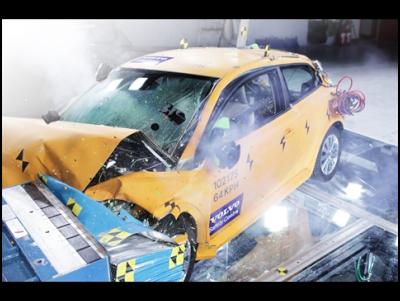C30 Electric car just as safe
C30 Electric car just as safe
Electric cars can be just as safe as any car according to Volvo.
On the company's stand at the Detroit Motor Show Volvo displayed a C30 Electric car that had undergone a frontal collision test at 64 km/h.
"Our tests show it is vital to separate the batteries from the electric car's crumple zones to make it as safe as a conventional car. In Detroit we are the first car maker to show the world what a truly safe electric car looks like after a collision with high-speed impact," says Volvo Cars' President and CEO Stefan Jacoby.
With climate change in focus, interest in electric cars has increased considerably. The electric motor is almost four times more energy-efficient than a combustion engine - and if the electric car is recharged using renewable energy it produces virtually no carbon dioxide emissions.

"The C30 Electric meets car buyers' increasing demands for minimised carbon dioxide emissions. However, this can under no circumstances come at the expense of other properties that customers expect of their Volvos. That is why our electric C30 has to be as comfortable, as usable, as fun to drive and as safe as all the other C30 variants," explains Lennart Stegland, director of Volvo Cars' Special Vehicles division.
The car on show is a Volvo C30 Electric, which had a fully charged battery when it was tested at Volvo Cars' crash test laboratory in early December 2010. The crash was an offset collision in which 40 percent of the front hit a barrier at 64 km/h.
"The test produced exactly the results we expected. The C30 Electric offers the very same high safety level as a C30 with a combustion engine. The front deformed and
distributed the crash energy as we expected. Both the batteries and the cables that are part of the electric system remained entirely intact after the collision," relates Jan Ivarsson, Senior Manager Safety Strategy & Requirements at Volvo Cars.
The structure of an electric car differs considerably from that of a conventional car - and the new components pose a number of new safety challenges.
In order to give the Volvo C30 Electric a range of up to 150 km it is necessary to have a battery pack that weighs about 300 kg and this takes up far more space than a conventional fuel tank. Under the bonnet, the combustion engine has been replaced by a more packaging-efficient and lighter electric motor. What is more, the car has a 400 Volt high-voltage electric system.
"Our research emphasises the importance of separating the lithium-ion batteries from the car's crumple zones and the passenger compartment. This is the same safety approach we apply with regard to the fuel tank in a conventional car. Another challenge is to reinforce the crumple zones at the front where the smaller motor occupies less space than usual," says Jan Ivarsson.
In the Volvo C30 Electric the batteries are fitted in the traditional fuel tank position and in the tunnel area. The batteries are robustly encapsulated. Beams and other parts of the car's structure around the battery pack are reinforced. All the cables are shielded for maximum protection.
The crash sensor in the car also controls the fuses - and power is cut in 50 milliseconds in a collision by the same signal that deploys the airbags.
The system has several fuses that cut directly if an earth fault is detected, such as a damaged cable coming into contact with the body frame.
In a conventional car, the combustion engine helps distribute the incoming collision forces. In the C30 Electric this task is performed by a reinforced frontal structure that also helps absorb the increased collision energy created as a result of the car's added weight.
The crash-tested cars are part of a rigorous test programme that also includes a large number of virtual crashes. Individual components and systems are also tested.
In addition to frontal full-scale tests, the C30 Electric has been subjected to other accident scenarios such as side collisions and rear-end impacts. The programme also includes front and side collisions with a rigid pole. The aim is to ensure that the car gives its occupants the best possible crash protection in the accident scenarios that are most frequent in real-life traffic.
"For us, the technology behind electric power is yet another exciting challenge in our drive to build the safest cars in the world," explains Jan Ivarsson.
Volvo Cars' electric car project currently encompasses about 250 vehicles that will be used by a number of companies and authorities. Deliveries of the first Volvo C30 Electric to customers in Sweden will start within weeks. A demo fleet is also planned for the United States later in 2011.
"Several car makers have launched or are in the process of introducing electric cars onto the market. We are carefully monitoring their progress and note that not everyone is approaching the safety challenges as we are,” said Stefan Jacoby. “But for us at Volvo, this issue is crystal clear. We never compromise on our stringent safety demands."
The Volvo C30 Electric
only represents one leg in Volvo Cars' electrification
strategy. There are two more.
• Volvo will introduce a
plug-in hybrid in Europe in 2012. It features a diesel
engine backing up the electrical motor. This cuts emissions
to less than 50g of CO2 per kilometre. Later, the plug-in
hybrid will come to the United States with a gasoline engine
backing up the electrical drive.
• The third leg is to
use power hybrids to give more miles to the gallon from
Volvo's new, upcoming generation of downsized engines.
"Personally, I believe that our non-compromise
electrical vehicles are one of the most important factors
for future success, especially in the U.S. We will stand out
from the crowd by delivering a distinct, individualist car
experience," says Stefan Jacoby
Facts, Volvo C30 Electric
Electric motor 82 kW
Top speed 130
km/h
Acceleration 0-100 km/h 10.5
sec
Batteries Lithium-ion 24 kWh
Charge 230V, 16A,
10A, 6A
Recharging duration 8-10 hours
Range 120-150
kms
Battery weight 2 x 140 kg
Weight increase compared
with a standard car
+ 300
kgs
ENDS


 Gordon Campbell: On unemployment, Winston Peters’ low boiling point and music criticism
Gordon Campbell: On unemployment, Winston Peters’ low boiling point and music criticism ACT New Zealand: Investment In Prisons Delivers On ACT Commitment
ACT New Zealand: Investment In Prisons Delivers On ACT Commitment Labour Party: National Gaslights Women Fighting For Equal Pay
Labour Party: National Gaslights Women Fighting For Equal Pay The Treasury: New Treasury Paper On The Productivity Slowdown
The Treasury: New Treasury Paper On The Productivity Slowdown NZ Government: Government Recommits To Equal Pay
NZ Government: Government Recommits To Equal Pay Emily Ireland - Local Democracy Reporter: Deputy Mayor ‘disgusted’ By Response To Georgina Beyer Sculpture
Emily Ireland - Local Democracy Reporter: Deputy Mayor ‘disgusted’ By Response To Georgina Beyer Sculpture Te Pāti Māori: Māori Unemployment Rate Increases By More Than Four-Times National Rates
Te Pāti Māori: Māori Unemployment Rate Increases By More Than Four-Times National Rates


